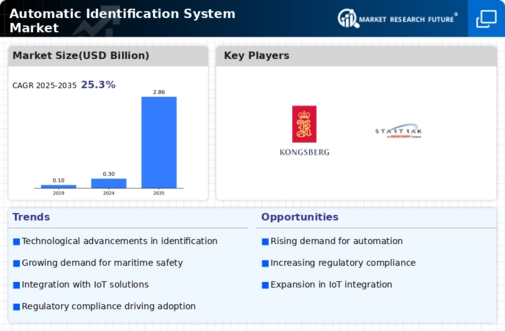Top Industry Leaders in the Automatic Identification System Market

Automatic Identification System (AIS) market
The Automatic Identification System (AIS) market has witnessed significant growth in recent years, driven by the increasing need for maritime safety, efficient navigation, and regulatory compliance. The competitive landscape of the AIS market reflects a dynamic industry where key players strive for innovation, strategic partnerships, and market expansion.
Key Players:
Exact Earth Ltd
Kongsberg Gruppen
SAAB AB
Furuno Electric Co. Ltd.
L-3 communication holdings
Orbcomm Inc
True Heading AB
Gramin International
Strategies Adopted: To maintain and enhance their market position, key players in the AIS market have adopted various strategies. Investments in research and development are a common approach, allowing companies to introduce advanced and feature-rich AIS solutions. Strategic collaborations and partnerships are also prevalent, enabling firms to complement their offerings with additional capabilities or expand their geographical presence.
Factors for Market Share Analysis: Several factors contribute to the analysis of market share in the AIS industry. Technological innovation, product reliability, and compliance with international regulations are critical determinants. Companies that invest in developing AIS solutions with enhanced features such as collision avoidance, route optimization, and integration with other maritime systems gain a competitive edge.
New and Emerging Companies: The AIS market has seen the emergence of new players that bring fresh perspectives and innovative solutions. Companies like ORBCOMM Inc., exactEarth Ltd., and CNS Systems AB have entered the arena with disruptive technologies, challenging the established order. These newcomers often focus on niche segments or introduce cost-effective solutions to gain traction in the market.
Industry News: Recent developments in the AIS market have showcased the industry's dynamic nature. Regulatory changes, such as the International Maritime Organization's (IMO) updated guidelines, drive innovation and compliance efforts among AIS providers. News of successful pilot projects or the implementation of AIS in novel applications, like fisheries management or environmental monitoring, keeps the industry in the spotlight.
Current Company Investment Trends: Investment trends in the AIS market reflect the industry's growth prospects and evolving technology landscape. Companies are allocating substantial funds to research and development to stay ahead in the technological curve. Additionally, strategic acquisitions and partnerships are prevalent, facilitating market consolidation and broadening the scope of services offered by key players.
Overall Competitive Scenario: The overall competitive scenario in the AIS market is characterized by intense rivalry, technological advancements, and a constant quest for market leadership. Established players face challenges from new entrants who leverage agility and innovation. The push for autonomous shipping and the integration of AIS with artificial intelligence and machine learning further intensify competition as companies race to provide intelligent and adaptive solutions.
Challenges and Opportunities: While the AIS market presents immense opportunities, it is not without challenges. Stricter regulatory requirements, cybersecurity concerns, and the need for seamless integration with existing maritime infrastructure pose hurdles for companies. However, these challenges also create opportunities for differentiation and growth, as companies that address these issues effectively gain a competitive advantage.
The Automatic Identification System market is poised for continued growth, driven by technological advancements and increasing maritime safety concerns. The competitive landscape reflects a mix of established players leveraging their experience and new entrants disrupting the market with innovative solutions. The strategies adopted by companies, market share analysis factors, and industry trends collectively shape the dynamic and evolving nature of the AIS market. As the industry continues to evolve, companies that can navigate regulatory landscapes, embrace technological innovation, and forge strategic partnerships will be best positioned to thrive in this competitive environment.
Recent News :
Acquisitions and partnerships:
Thales Group acquires majority stake in Exactearth: In October 2023, Thales Group, a French multinational electronics company, acquired a majority stake in Exactearth, a leading provider of satellite-based AIS data and services. This move strengthens Thales' position in maritime surveillance and traffic management.
Wartsila partners with Kongsberg for next-generation AIS: In September 2023, Wärtsilä, a Finnish marine technology company, announced a partnership with Kongsberg, a Norwegian technology company, to develop next-generation AIS solutions for autonomous ships.
Product launches and innovations:
Garmin introduces new AIS transponders with integrated GNSS: In November 2023, Garmin launched new AIS transponders with integrated Global Navigation Satellite Systems (GNSS) for improved accuracy and reliability.
Orbcomm expands satellite AIS coverage in Arctic: In December 2023, Orbcomm, a global provider of satellite IoT solutions, announced expanded satellite AIS coverage in the Arctic region, enabling improved safety and maritime awareness in this increasingly critical area.
Regulatory developments:
IMO mandates Class B AIS for fishing vessels: In November 2023, the International Maritime Organization (IMO) adopted a mandatory requirement for fishing vessels of 24 meters and above to carry Class B AIS transponders, enhancing safety and traceability in the fishing industry.
Market trends and forecasts:
Growing demand for satellite AIS: The demand for satellite AIS is expected to grow significantly in the coming years, driven by increasing maritime traffic, environmental concerns, and the need for real-time vessel tracking in remote areas.
Asia Pacific region leading the growth: The Asia Pacific region is expected to be the fastest-growing market for AIS due to its booming maritime trade and investments in port infrastructure.


